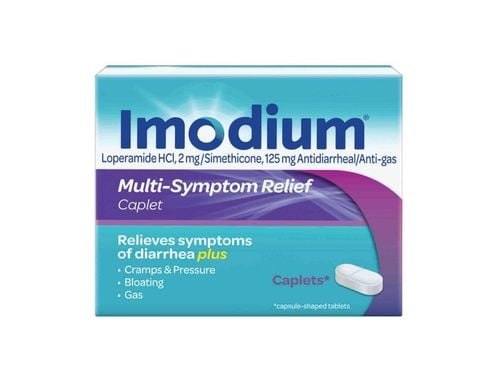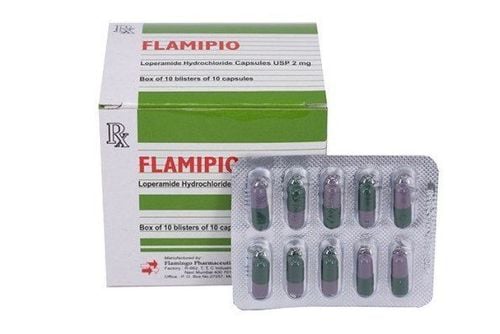This is an automatically translated article.
Flamipio is a drug commonly used to treat diarrhea that works to treat chronic or acute diarrhea that can have many causes. To better understand what is Flamipio? What disease does flamipio treat? What are the harmful interactions of Flamipio? What is the correct way to drink? What points should you pay attention to when using? The following article will help you better understand the drug Flamipio.
1. What is Flamipio?
Flamipio is a medicine for diarrhea with the main ingredient Loperamide Hydrochloride USP 2mg and some other excipients just enough for 1 tablet including: Lactose Monohydrate, Maize Starch, Colloidal anhydrous silica (Aerosil 200), Magnesium Stearate. Purified Tale, Sodium Starch Glycolate.Packing: Each box of Flamipio has 10 blisters, each blister has 10 capsules.
2. Pharmacodynamics
Loperamide is a pharmaceutical containing active ingredients that bind to opiate receptors in the intestinal wall, reducing mucosal irritation and stimulating gastrointestinal contractions. Reduces intestinal peristalsis, prolongs circulation time in the intestinal lumen. Loperamide increases the tone of the anal sphincter thereby reducing urgency in the incontinence reflex. Because the drug has a high affinity for the intestine and is metabolized mainly in the first pass through the liver, it is difficult to reach the systemic circulation. Loperamide inhibits intestinal motility due to its direct peripheral effect on the intestinal wall. Studies in animals have shown that effects on the central nervous system appear only when the drug is used at doses in excess of those used in humans. Therefore, loperamide can reasonably be used for symptomatic treatment of acute and chronic diarrhea, and to increase circulation and absorption time in patients after ileostomy.
3. Pharmacokinetics
Loperamide is readily absorbed from the intestine (about 40% of a dose of loperamide is absorbed from the intestine) but most of it is filtered and metabolized by the liver to the inactive form (more than 50%) and is excreted in the feces and urine. both unchanged and transformed (30-40%). The concentration of drug excreted in milk is very low. Binding to plasma proteins is about 97%. The half-life of loperamide in humans ranges from 9-14 hours. Excreted mainly through feces.
4. What effect does Flamipio have?
Main active ingredient Loperamide is a synthetic antidiarrheal agent used to control signs of chronic diarrhea and nonspecific acute diarrhea associated with inflammatory bowel disease. The mechanism of action of Loperamide is to prolong the transit time of the intestinal mass. Besides, the drug also works to reduce daily stool volume, increase viscosity and reduce the risk of dehydration and electrolyte loss of the body. In addition, Loperamide is an opioid receptor agonist and acts on opioid receptors in the large intestine. Unlike other opioid agonists such as morphine, codeine, ... Loperamide has no effect on the central nervous system, thus avoiding unwanted effects on the nervous system. The specific mechanism of the drug is to reduce the activity of the muscular plexus in the large intestine, reduce the peristalsis of the sphincter and longitudinal muscles of the intestinal wall, leading to a longer retention time of the intestinal mass. Another mechanism of Loperamide is inhibition of the gastro-intestinal reflex.
5. Flamipio side effects
During the treatment of diarrhea with Flamipio, patients may experience undesirable effects on the immune system such as hypersensitivity reactions, including anaphylaxis, but rarely. On the digestive system, the drug can cause unusual symptoms such as constipation, nausea, flatulence with common frequency; dry mouth, abdominal pain, vomiting infrequently; or, rarely, paralytic ileus. Patients may also experience side effects on the nervous system with varying frequency such as frequent headaches; Rarely dizziness, and rare symptoms of loss of consciousness, movement disorders. In addition, the drug also causes symptoms of rash (uncommon), rarely itching, urticaria, angioedema, Steven Johnson syndrome, toxic epidermal necrolysis, urinary retention, ...
6. Adverse drug interactions of Flamipio
Itraconazole is an antifungal agent that inhibits both cytochrome 3A4 and P-glycoprotein. Therefore, if this drug is used concurrently, the plasma concentration of Loperamide will increase 3-4 times compared to when used alone. In particular, if you use Gemfibrozil at the same time, the peak concentration of Loperamide in the blood is 4-fold, along with the total systemic exposure also increased by 13-fold. Another antifungal agent, Ketoconazole, will also interact with Loperamide by the same mechanism as Itraconazole, but to a greater extent. It also increases the plasma concentration of Loperamide up to 5 times. Quinidine and ritonavir are P-glycoprotein inhibitors. Therefore, when the two drugs are used together with Loperamide, there will be an interaction that leads to an increase in the concentration of Loperamide in the blood by 2-3 times compared to when used alone. Therefore, it is necessary to adjust the dose accordingly to avoid the risk of overdose or increase the risk of unwanted effects. Drugs that accelerate the movement of food particles in the digestive tract have an antagonistic effect on Loperamide, leading to a decrease in the therapeutic effect of Flamipio. Besides, Loperamide also interacts to change the concentration of the drug used with it. For example, a 3-fold increase in the plasma concentration of Desmopressin may be explained, possibly because Loperamide reduces intestinal motility.7. How to use Flamipio effectively
7.1. Dosage You should swallow the capsule whole with a glass of water. For children or people with difficulty swallowing, the capsule can be separated and powdered in a glass of water and then taken. Or you can follow the instructions of your doctor or pharmacist.
7.2. Dosage for adults Acute diarrhea: When diarrhea first appears, take 2 tablets. After that, if the condition does not improve, then take another pill after 4-6 hours. Drink up to 5 days. If it still does not go away, you need to consult a doctor.
Chronic diarrhea: Start with 2 tablets/day; maintain 1-6 tablets/day. Do not take more than 8 tablets a day.
7.3. Pediatric Dosage Loperamide is not recommended for routine pediatric use in acute diarrhea.
Children from 6 to 8 years old: Take 2 capsules a day
Children from 8 to 12 years old: Take 3 tablets a day. Maintenance dose: Take 1 mg/10 kg of body weight, only after 1 bowel movement.
For children under 6 years old: Use
7.4 is not recommended. Overdose, missed dose and management Overdose: Manifestations of overdose such as CNS depression: drowsiness, decreased muscle tone, respiratory depression, miosis and intestinal obstruction may occur. Overdose in children is much more dangerous than in adults.
Treatment: If symptoms of overdose occur, use naloxone to detoxify. Closely monitor patient's symptoms during detoxification.
Missed dose: Do not take a double dose to make up for the missed dose, as this will not make up for the missed dose and increases the risk of overdose. If you have any further questions about how to take this medicine ask your doctor or pharmacist.
8. Be careful when using Flamipio
8.1. Notes when using Flamipio drug Flamipio drug is not a drug for rehydration and electrolytes, so when diarrhea is acute or chronic, it is necessary to use preparations to supplement water and electrolytes for the patient.
When using Flamipio but the symptoms do not improve within 48 hours, the patient should not use Flamipio anymore. The cause of the diarrhea must be considered.
If it is imperative to administer to patients with liver dysfunction, close monitoring is required for signs of neurotoxicity.
In patients with acute colitis, broad-spectrum antibiotic-associated pseudomembranous colitis, Flamipio inhibits intestinal motility, resulting in increased intestinal transit time leading to colon toxicity.
Discontinue use if patient develops constipation.
Other health problems: The presence of other medical conditions may affect the use of Loperamide. Patients must inform the treating physician in case of other health problems, especially conditions such as colitis (severe), dysentery, liver disease. In these cases, loperamide should be avoided.
8.2. Effects on pregnancy and lactation Pregnant women: In animal clinical studies, loperamide did not cause cancer or teratogenicity, did not reduce the ability to conceive. However, scientists recommend that you should weigh the benefits and effects of loperamide when using the drug for pregnant patients, especially around the first 3 months of pregnancy.
Lactation: Loperamide is likely to be excreted in breast milk, so loperamide is not recommended for nursing women.
9. Storing Flamipio:
Store this medication in a dry place, away from direct sunlight, at a temperature below 30°C.
Please dial HOTLINE for more information or register for an appointment HERE. Download MyVinmec app to make appointments faster and to manage your bookings easily.













